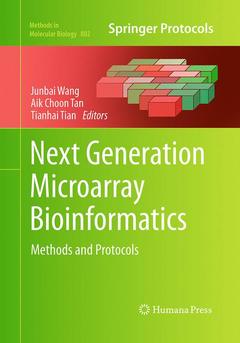Description
Next Generation Microarray Bioinformatics, Softcover reprint of the original 1st ed. 2012
Methods and Protocols
Methods in Molecular Biology Series, Vol. 802
Coordinators: Wang Junbai, Tan Aik Choon, Tian Tianhai
Language: English
Publication date: 08-2016
Support: Print on demand
Publication date: 12-2011
401 p. · 17.8x25.4 cm · Hardback
Description
/li>Contents
/li>Comment
/li>
Recent improvements in the efficiency, quality, and cost of genome-wide sequencing have prompted biologists and biomedical researchers to move away from microarray-based technology to ultra high-throughput, massively parallel genomic sequencing (Next Generation Sequencing, NGS) technology. In Next Generation Microarray Bioinformatics: Methods and Protocols, expert researchers in the field provide techniques to bring together current computational and statistical methods to analyze and interpreting both microarray and NGS data. These methods and techniques include resources for microarray bioinformatics, microarray data analysis, microarray bioinformatics in systems biology, next generation sequencing data analysis, and emerging applications of microarray and next generation sequencing. Written in the highly successful Methods in Molecular Biology? series format, the chapters include the kind of detailed description and implementation advice that is crucial for getting optimal results in the laboratory.
Authoritative and practical, Next Generation Microarray Bioinformatics: Methods and Protocols seeks to aid scientists in the further study of this crucially important research into the human DNA.
A Primer on the Current State of Microarray Technologies.- The KEGG Databases and Tools Facilitating Omics Analysis: Latest Developments Involving Human Diseases and Pharmaceuticals.- Strategies to Explore Functional Genomics Data Sets in NCBI’s GEO Database.-Analyzing Cancer Samples with SNP Arrays.- Classification Approaches for Microarray Gene Expression Data Analysis.-Biclustering of Time Series Microarray Data.- Using the Bioconductor GeneAnswers Package to Interpret Gene Lists.- Analysis of Isoform Expression from Splicing Array using Multiple Comparisons.- Functional Comparison of Microarray Data across Multiple Platforms Using the Method of Percentage of Overlapping Functions.- Performance Comparison of Multiple Microarray Platforms for Gene Expression Profiling.- Integrative Approaches for Microarray Data Analysis-.Modelling Gene Regulation Networks using Ordinary Differential Equations.- Non-homogeneous Dynamic Bayesian Networks in Systems Biology.- Inference of Regulatory Networks from Microarray Data with R and the Bioconductor Package qpgraph.- Effective Nonlinear Methods for Inferring Genetic Regulation from Time-series Microarray Gene Expression Data.- An Overview of the Analysis of Next Generation Sequencing Data.- How to Analyze Gene Expression using RNA-Sequencing Data.- Analyzing ChIP-seq Data: Preprocessing, Normalization, Differential Identification and Binding Pattern Characterization.- Identifying Differential Histone Modification Sites from ChIP-seq Data.- ChIP-Seq Data Analysis: Identification of Protein-DNA Binding Sites with SISSRs Peak Finder.- Using ChIPMotifs for de novo Motif Discovery of OCT4 and ZNF263 based on ChIP-based High-throughput Experiments.- Hidden Markov Models for Controlling False Discovery Rate in Genome-Wide Association Analysis.- Employing Gene Set Top Scoring Pairs to Identify Deregulated Pathway-Signatures in Dilated Cardiomyopathy from Integrated Microarray Gene ExpressionData.-JAMIE: A Software Tool for Jointly Analyzing Multiple ChIP-chip Experiments.- Epigenetic Analysis: ChIP-chip and ChIP-seq.- BiNGS!SL-seq: A Bioinformatics Pipeline for the Analysis and Interpretation of Deep Sequencing Genome-wide Synthetic Lethal Screen.
These books may interest you

Tumor ProfilingMethods and Protocols 105.49 €



